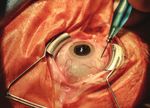The Benefits of Trocar-Based Chandelier Vitreoretinal Surgery
←
→
Page content transcription
If your browser does not render page correctly, please read the page content below
s UPDATE YOUR SURGICAL TOOLBOX
The Benefits of Trocar-Based
Chandelier Vitreoretinal Surgery
A new option eases surgical maneuvers in challenging cases.
BY ANDREAS POLLREISZ, MD
I
n the past few decades, we have seen numerous techno- CLINICAL PERSPECTIVE
logical advances for vitrectomy, the most notable being The most important aspect of the self-retaining Oertli
the reduction of surgical instrument sizes. Now, vitreoreti- chandelier illumination system for me is its ability to provide
nal surgeons are performing transconjunctival microinci- hands-free homogeneous and diffuse widefield illumination,
sion vitrectomy with 23- to 27-gauge systems, making allowing fully bimanual surgical procedures.
possible sutureless surgical procedures that significantly My preference for the placement of the chandelier system
improve patient safety, comfort, and recovery. is at the 12 clock position. This casts the instrument shadows
However, these smaller gauges require powerful endoil- anteriorly so that they do not coincide with my working
lumination systems. The first optical fiber probes introduced area. In addition, I can easily modify the tip of the optical
by Peyman in 1976 for 20-gauge systems have largely been fiber from this position without any obstacles. However,
replaced with wide-angle endoillumination models.1,2 Today, there are certain conditions in which a different chandelier
a wide variety of products are available from different manu- location provides better visualization.
facturers ranging from single-fiber to dual-fiber chandeliers. There are a number of surgical indications in my clinical
Some are inserted into the vitreous cavity through a sepa- routine that require both hands for intraocular manipula-
rate sclerotomy without a cannula, and others are inserted tions, including the following:
through standard 23- to 27-gauge trocar systems. One of
the main advantages of a chandelier endoillumination sys- Retinal Detachment
tem is that it frees up one of the surgeon’s hands, allowing In complex retinal detachment (RD) cases with advanced
bimanual surgical procedures. proliferative vitreoretinopathy presenting with pre- or sub-
retinal membranes, bimanual excision of the fibrotic tissues is
RETHINK MANEUVERABILITY
A new flexible chandelier system (Oertli Instruments) is
a single-fiber trocar-based self-retaining system available
AT A GLANCE
with or without sheathing of the fiber at the distal end; the A chandelier endoillumination system frees up one
s
version without the sheathing is extremely flexible. After a of the surgeon’s hands, allowing bimanual surgical
25- or 27-gauge trocar is placed in the pars plana region, the
tip of the endoillumination fiber is attached with a snap-lock
procedures.
connection (Figure 1). Flexible repositioning is possible with Placing the chandelier system at the 12 clock position
s
other trocars from the Oertli Caliburn system. casts the instrument shadows anteriorly, avoiding any
Forming a loop with the flexible part of the unsheathed fiber shadowing in the working area.
allows the chandelier to be moved freely during the surgical
A number of surgical indications require both hands
s
procedure (Figure 2). The fiber with sheathing must be inflected
manually to create the loop necessary for correct positioning. for intraocular manipulations, including complex
A sterile strip is then used to fix the sheathed part of the fiber. tractional retinal detachments in diabetic eyes, foreign
Creating a flap in the strip (Figure 3) allows the chandelier to be body retrieval and pediatric cases.
lifted and repositioned in all directions with ease.
30 RETINA TODAY | JANUARY/FEBRUARY 2021UPDATE YOUR SURGICAL TOOLBOX
s
A B C
Figure 1. Setup of the 25-gauge single-fiber trocar-based chandelier system connected to the OS4 surgical platform (Oertli Instruments). After the trocar is inserted (A), a snap-lock connection
(B) ensures a tight seal between the fiber tip and the trocar (C).
often the only maneuver possible to relieve the retina, allow microscope and a wide-angle viewing system.4 In most of my
reattachment, and prevent redetachment (Figure 4).3 RD cases I choose primary vitrectomy; thus, my preferred
Eyes with tractional RDs due to proliferative diabetic view of the retina is through a noncontact wide-angle view-
retinopathy are ideal candidates for bimanual procedures. ing system. This allows me to adjust magnification and image
Particularly, the use of 25- and 27-gauge continuous flow focus to detect small defects under indentation that I would
cutter probes with a dual blade design at high cutting rates potentially miss under indirect ophthalmoscopy.
and a cutting port close to the tip of the instrument allows Because more surgeons are using vitrectomy for RD repair,
controlled removal of membranes and delamination of the many are now less experienced with ab externo detach-
fibrovascular membrane from the underlying retina. ment procedures. This makes chandelier-assisted buckling
For a secure procedure, I usually have forceps or a spatula attractive as a safe alternative. In placing a scleral buckle, I
in the other hand to grasp and stabilize the retina, which position the chandelier fiber in the pars plana area opposite
requires hands-free illumination. With this technique, I can from the region where the buckle will be sutured onto the
better visualize the plane for dissection and thereby limit the sclera. With this positioning, the wide-angle viewing system
risk of creating a break. provides the best visualization, with no shadowing of the
The self-holding chandelier allows me to have one hand retinal defects, an optimal view for successful cryoretinopexy,
available for scleral indentation when I perform RD surgery and the correct location after placement of the buckle.
without an assistant. With this setup, I can accomplish
controlled, safe shaving of the peripheral vitreous base and Diabetic Retinopathy
complete removal of vitreous from the retinal defects. I can In diabetic patients, blood leaking from neovascularization
also perform autonomous endolaser treatment of peripheral can severely impair visualization, and applying diathermy
retinal areas accessible only with indentation (Figure 5). If a at the location of the leak may not be feasible due to quick
retinal defect cannot be sufficiently dried to permit endola- blood accumulation. In these instances, a bimanual proce-
ser treatment, I can use a soft-tip cannula in one hand and dure with a soft-tip cannula in one hand and the endodia-
the endolaser in the other to apply laser burns. thermy probe in the other can help significantly.
Chandelier illumination is quite useful when performing In our clinic we see many patients with diabetes who have
a scleral buckling procedure for the treatment of rheg- vitreous hemorrhage and dense cataract. A phacoemulsifi-
matogenous RD, as the localization of the retinal breaks and cation-vitrectomy is the preferred treatment choice when
cryoretinopexy can be accomplished through the surgical intraocular bleeding is not clearing or a concurrent RD is
Figure 2. Making a loop in the fiber allows compensation for surgical movements. Figure 3. Creating a flap in the sterile strip allows easy repositioning of the chandelier.
JANUARY/FEBRUARY 2021 | RETINA TODAY 31s UPDATE YOUR SURGICAL TOOLBOX
A B
Figure 4. In this eye with a retinal detachment affecting all four quadrants, widefield endoillumination is achieved with the 25-gauge Oertli flexible endoillumination system (A). Quickly
repositioning the chandelier tip to the upper temporal trocar provided the best illumination of the nasal retinal quadrant. The surgeon performed indentation with one hand while shaving the
vitreous base with the cutter held in the other hand without the need of a skilled assistant (B).
diagnosed on ultrasound. However, phacoemulsification can in children may be complicated, and a bimanual approach
be challenging in eyes with dense intravitreal hemorrhage using forceps and scissors can help.
because the structure of the lens cannot be visualized
sufficiently due to the missing fundus red reflex.5 Object Retrieval
In my experience, using a chandelier-based intraocular lighting Chandelier illumination can be particularly useful when
system can significantly reduce complications such as posterior retrieving a dropped nucleus after cataract surgery or an intra-
capsular tears, as the retroillumination improves visualization. I ocular foreign body located on the retina. With a bimanual
typically sit at the 12 clock position and place the chandelier at approach, one hand brings the object into the mid-vitreous
the temporal side in the pars plana. After completing the lens with forceps or a soft-tip cannula, respectively. I prefer not to
extraction and IOL implantation, I continue using the chande- grasp a foreign body directly when it is located on the retinal
lier system to address the hemorrhage, but I often reposition it surface, particularly in the macular area, as this might induce
more superiorly for better intraocular views. retinal damage. Instead, from the center of the vitreous cavity,
I transfer the object directly to a hook or forceps held in the
Pediatric Cases other hand for secure placement of the lens into the anterior
In pediatric vitrectomy, achieving posterior vitreous chamber or removal of the foreign body through a sclerotomy.
detachment is often challenging, and operating with the vit-
reous cutter in one hand and forceps in the other facilitates a FINAL THOUGHTS
successful maneuver. Similarly, epiretinal membrane removal The use of a trocar-based chandelier system for endoillumi-
nation can significantly increase the surgical success rate in a
number of vitreoretinal indications by allowing bimanual intra-
ocular manipulation. The ease of use, compatibility with 23- to
27-gauge systems, and the extrawide and homogeneous endoil-
lumination provided by the Oertli chandelier allows me to safely
and efficiently perform many challenging cases. n
1. Peyman GA. Improved vitrectomy illumination system. Am J Ophthalmol. 1976;81(1):99-100.
2. Peyman GA, Canakis C, Livir-Rallatos C, Easley J. A new wide-angle endoillumination probe for use during vitrectomy.
Retina. 2002;22(2):242.
3. Idrees S, Sridhar J, Kuriyan AE. Proliferative vitreoretinopathy: a review. Int Ophthalmol Clin. 2019;59(1):221–240.
4. Cohen E, Rosenblatt A, Bornstein S, Loewenstein A, Barak A, Schwartz S. Wide-angled endoillumination vs traditional
scleral buckling surgery for retinal detachment - a comparative study. Clin Ophthalmol. 2019;13:287-293.
5. Nagpal MP, Mahuvakar SA, Chaudhary PP, Mehrotra NS, Jain AK. Chandelier-assisted retroillumination for phacoemulsifica-
tion in phacovitrectomy. Indian J Ophthalmol. 2018;66(8):1094-1097.
ANDREAS POLLREISZ, MD
Figure 5. The self-retaining Oertli 27-gauge chandelier system frees one hand for n Associate Professor of Ophthalmology, Vitreoretinal Surgeon, Department of
indentation to perform endolaser treatment in peripheral retinal areas after the vitreous Ophthalmology, Medical University Vienna, Vienna, Austria
n a ndreas.pollreisz@meduniwien.ac.at
cavity is cleared of hemorrhage. In this patient with a branch retinal artery occlusion,
n F inancial disclosure: Consultant (Hoffmann-La Roche, Novartis, Oertli
recurrent vitreous bleeding occurred in a previously vitrectomized and photocoagulated
eye due to active neovascularization. Instruments)
32 RETINA TODAY | JANUARY/FEBRUARY 2021You can also read



























































